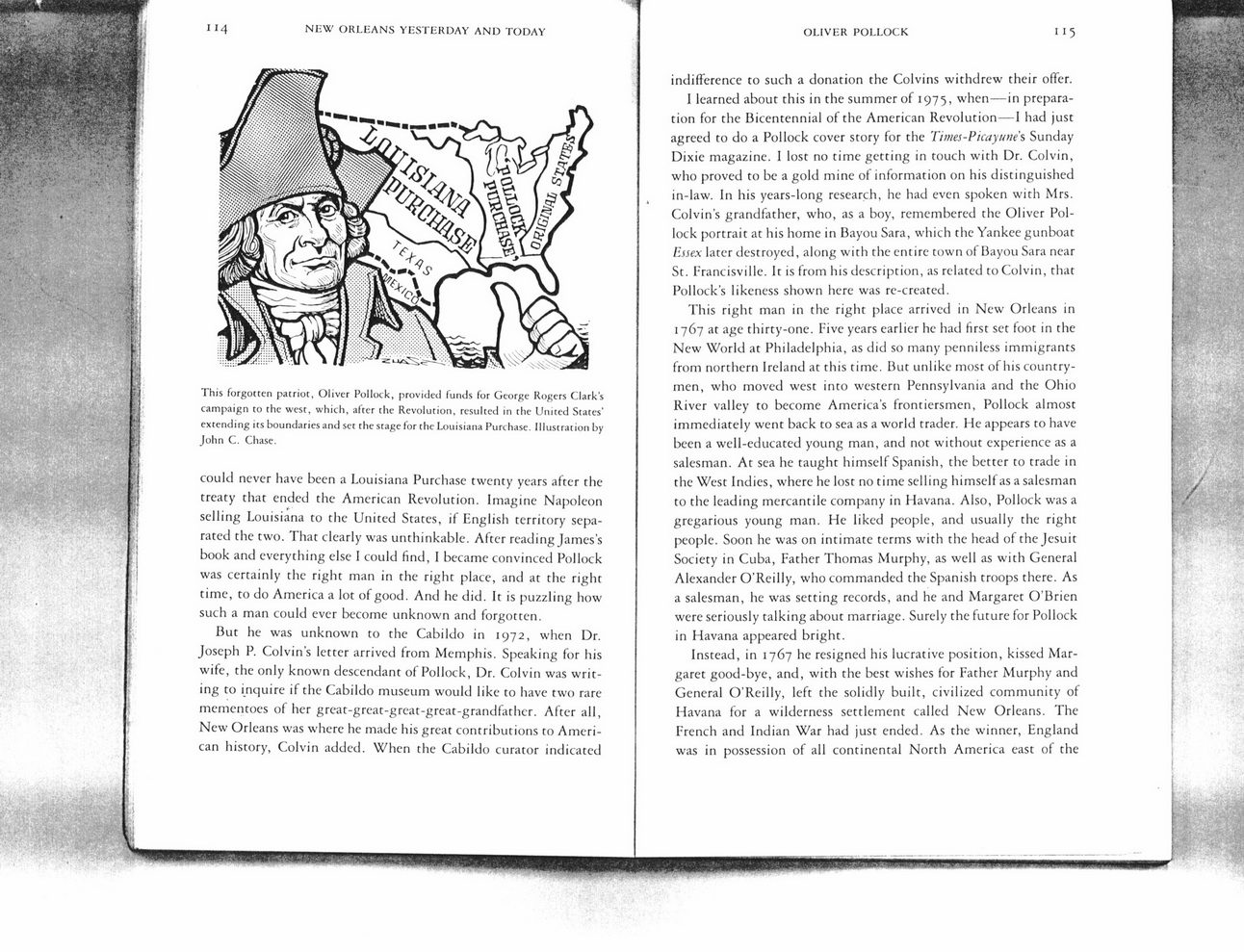This text was obtained via automated optical character recognition.
It has not been edited and may therefore contain several errors.
ii4 NEW ORLEANS YESTERDAY AND TODAY This forgotten patriot, Oliver Pollock, provided funds for George Rogers Clark's campaign to the west, which, after the Revolution, resulted in the United States' extending its boundaries and set the stage for the Louisiana Purchase. Illustration by John C. Chase. could never have been a Louisiana Purchase twenty years after the treaty that ended the American Revolution. Imagine Napoleon selling Louisiana to the United States, if English territory separated the two. That clearly was unthinkable. After reading James's book and everything else I could find, 1 became convinced Pollock was certainly the right man in the right place, and at the right time, to do America a lot of good. And he did. It is puzzling how such a man could ever become unknown and forgotten. But he was unknown to the Cabildo in 1972, when Dr. Joseph P. Colvin's letter arrived from Memphis. Speaking for his wife, the only known descendant of Pollock, Dr. Colvin was writing to inquire if the Cabildo museum would like to have two rare mementoes of her great-great-great-great-grandfather. After all, New Orleans was where he made his great contributions to American history, Colvin added. When the Cabildo curator indicated OLIVER POLLOCK 115 indifference to such a donation the Colvins withdrew their offer. 1 learned about this in the summer of 1975, when?in preparation for the Bicentennial of the American Revolution ? I had just agreed to do a Pollock cover story for the Times-Picayune?s Sunday Dixie magazine. 1 lost no time getting in touch with Dr. Colvin, who proved to be a gold mine of information on his distinguished in-law. In his years-long research, he had even spoken with Mrs. Colvin's grandfather, who, as a boy, remembered the Oliver Pollock portrait at his home in Bayou Sara, which the Yankee gunboat Essex later destroyed, along with the entire town of Bayou Sara near St. Francisville. It is from his description, as related to Colvin, that Pollock's likeness shown here was re-created. This right man in the right place arrived in New Orleans in 1767 at age thirty-one. Five years earlier he had first set foot in the New World at Philadelphia, as did so many penniless immigrants from northern Ireland at this time. But unlike most of his countrymen, who moved west into western Pennsylvania and the Ohio River valley to become America's frontiersmen, Pollock almost immediately went back to sea as a world trader. He appears to have been a well-educated young man, and not without experience as a salesman. At sea he taught himself Spanish, the better to trade in the West Indies, where he lost no time selling himself as a salesman to the leading mercantile company in Havana. Also, Pollock w'as a gregarious young man. He liked people, and usually the right people. Soon he was on intimate terms with the head of the Jesuit Society in Cuba, Father Thomas Murphy, as well as with General Alexander O?Reilly, who commanded the Spanish troops there. As a salesman, he was setting records, and he and Margaret O'Brien were seriously talking about marriage. Surely the future for Pollock in Havana appeared bright. Instead, in 1767 he resigned his lucrative position, kissed Margaret good-bye, and, with the best wishes for Father Murphy and General O'Reilly, left the solidly built, civilized community of Havana for a wilderness settlement called New Orleans. The French and Indian War had just ended. As the winner, England was in possession of all continental North America east of the

Pollock Family 005